The Royal Courts of Africa: Majesty and Heritage Explored Through Their Rich History and Culture!
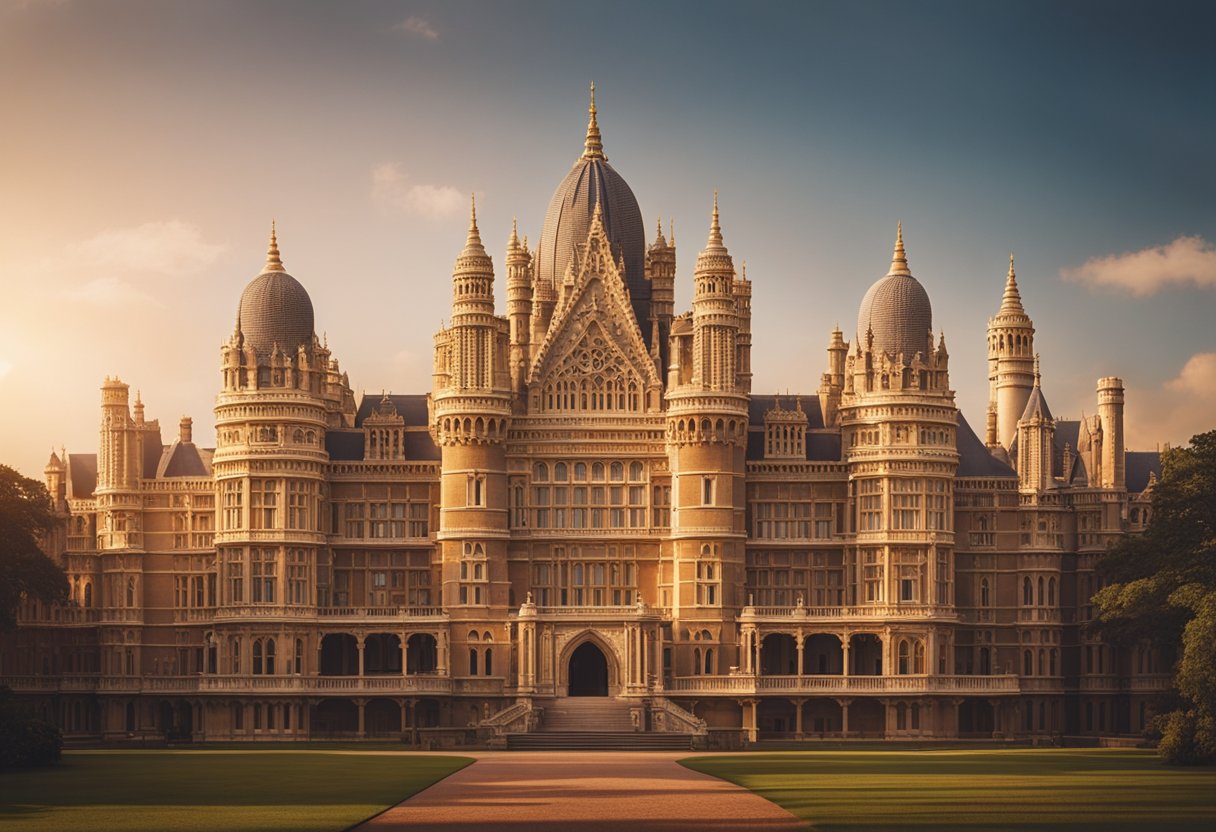
Updated On: April 23, 2024 by Esraa Mahmoud
The African continent is often celebrated for its vibrant cultures and rich heritage, and among the most captivating aspects of this diversity are the royal courts of Africa, which stand as symbols of both majesty and heritage. From the ancient kingdoms that shaped the early history of Africa to the resilient monarchies that maintain their influence today, these royal establishments are steeped in tradition and are pivotal aspects of African culture. Across the continent, regal pageantry and the customs of court life provide a window into the depth of Africa’s majestic past and its ongoing cultural narrative.
Royal households in Africa are not simply relics of bygone eras but continue to play a significant role in modern times. They encompass a range of functions, from the ceremonial to the political, reflecting both the continuity and the evolution of African societies. For instance, the regalia and symbols of royalty are pieces of art that embody the history and societal values of the nations they represent. Meanwhile, the cultural heritage and the arts that thrive within these courts inform and inspire local and international communities, preserving a legacy that transcends time.
Historical Overview of African Monarchies & The Royal Courts of Africa!
African monarchies encapsulate a rich tapestry of histories, from the illustrious pharaohs of Ancient Egypt to the grandeur of West Africa’s empires. This section traverses the continuum of royal dominions and the resilience of African sovereignties amid foreign dominations.
Ancient Kingdoms and Dynasties
The African continent has been home to a myriad of kingdoms and dynasties. Mali and Ghana were among the most notable empires of West Africa, renowned for their immense wealth and influential monarchs, such as Mansa Musa of Mali. These dynasties were structured around complex social hierarchies, with kings and queens central in governance and culture.
Ancient Egypt is particularly esteemed, where pharaohs ruled as god-kings and erected monumental, awe-inspiring architecture. It stood as a beacon of civilisation during antiquity, influencing later cultures and empires including the Roman Empire and the Ottoman Empire.
Ethiopia also boasts a long lineage of monarchies, with traditions suggesting a link to the biblical King Solomon. Their enduring legacy is evident in the rock-hewn churches of Lalibela and the story of the Queen of Sheba.
Colonial Impact on African Sovereignties
Colonisation had a profound impact on African sovereignties. The incursions of the British Empire into African countries led to the diminishing role of traditional monarchies, replacing indigenous systems with foreign structures. Nevertheless, nations like Nigeria witnessed royal courts adapting to newly imposed colonial policies while still striving to preserve their regal customs.
In some instances, monarchies served as intermediaries between the colonisers and the local populace. The persistent influence of traditional rulers within the communal fabric demonstrates the resilience of these African monarchies during and after the colonial era. Their legacy continues to be embedded in the historical consciousness of various African societies today.
The Political Role of Monarchs in Africa
African monarchies have navigated the complex interplay between traditional authority and the modern state. Their roles vary from purely ceremonial to significantly influential in national politics.
Modern Politics and Traditional Authority
In some African countries, monarchs retain considerable influence over state affairs. They often serve as custodians of culture and heritage, with a unique role in legitimating political authority. These royal figures can sway public opinion during elections, although their political power may not be constitutionally defined. Take Lesotho, a constitutional monarchy where the king’s role has evolved but remains symbolic, without direct governance power.
Contrastingly, Eswatini stands out as an African country where the monarch holds absolute power. In this context, the king’s court is central to traditional and governmental functions, influencing the political landscapes significantly. King Mswati III exemplifies a monarch with substantial control over the state’s political and economic matters.
Non-Governmental Relations
Outside the formal political sphere, African monarchs often forge solid non-governmental relations. They engage with charitable organisations, international bodies, and community groups. This involvement allows them to contribute to societal progress, promoting education, health, and social cohesion.
Moreover, former royals can still exert cultural influence in countries transitioning from monarchical rule. For instance, in countries where the monarchy has been dissolved or rendered ceremonial, former monarchs may continue to lead through moral authority or by heading pivotal cultural institutions.
Through these varying roles, African monarchs demonstrate the capacity to influence both the political and social realms, reflecting a blend of heritage and contemporary governance.
Ceremonies and Royal Customs
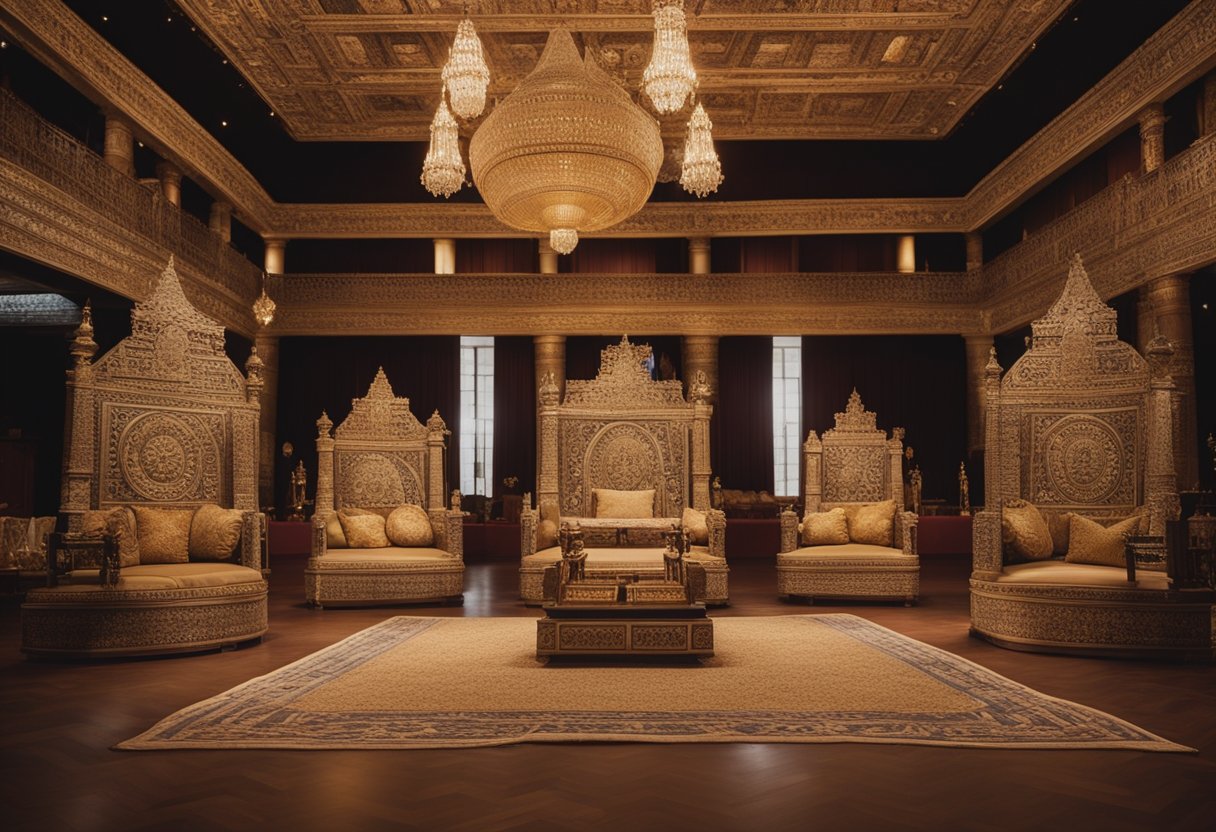
In the vibrant tapestry of African culture, ceremonies and royal customs stand out for their depth of tradition and splendour. They serve not only as celebrations of heritage but also as a reinforcement of the societal structure.
Coronations and Investitures
Coronations in Africa are elaborate affairs that mark the ascension of a new monarch, referred to with reverence as His Majesty. This solemn occasion is peppered with age-old traditions, including wearing specific regalia that symbolises the sovereign’s authority and the continuity of the lineage. During the coronation, the new king or queen receives titles and tributes from dignitaries and the public, affirming their status as the embodiment of the nation’s identity and unity.
For example, the large photo from 2012 depicting a seated Nigerian king captures the regal aura and the intricate attire associated with such coronation ceremonies, showcasing the luxury and cultural significance embedded in African royalty.
Festivals and National Celebrations
Festivals and national celebrations are integral to African royal tradition, offering a kaleidoscope of sounds, colours, and communal joy. These events often coincide with significant dates in the nation’s history or the natural cycles, such as harvests, serving as an opportunity for the monarch to preside over festivities and engage with the citizenry.
Ceremonies like entering the kraal, a sacred Zulu royal custom, exemplify the significance of these traditions. On the other hand, national festivals see the royalty partaking in performances, feasts, and processions, reinforcing their role as keepers of cultural heritage and bridging past, present, and future generations.
Cultural Heritage and the Arts
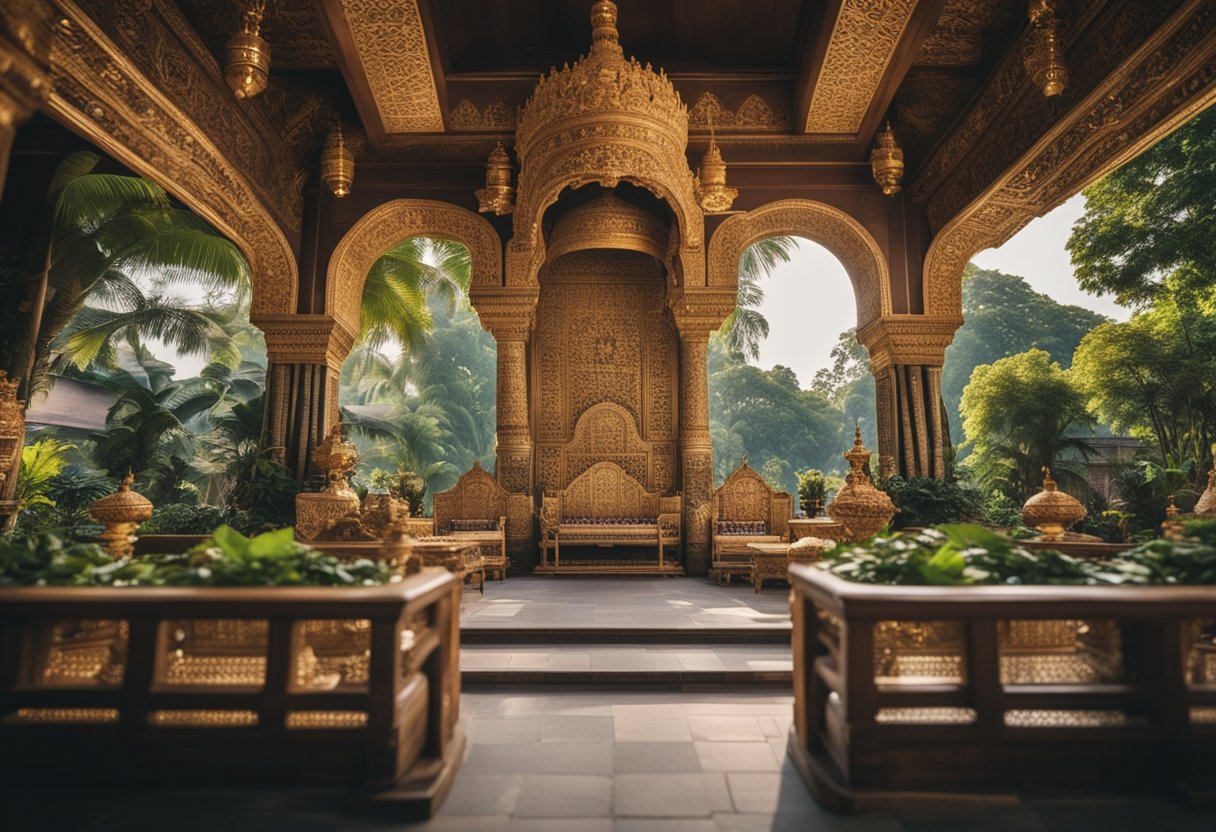
The royal courts of Africa have long been epicentres of cultural and artistic expression, serving as both patrons and preservers of the continent’s rich heritage.
Royal Patronage of the Arts
Royal patronage has historically played a vital role in the flourishing of African art. Kings and queens, deeply embedded in the cultural fabric of their societies, often commissioned works to adorn their palaces and to serve as symbols of their authority. Artisans within these courts were esteemed for their craftsmanship, creating intricate sculptures, masks, and textiles that reflected the nobility’s power and captured the spirit of the people. This form of artistic patronage provided livelihoods for skilled craftsmen and encouraged the development of distinctive artistic styles unique to each royal court. For detailed insights, the Royal Arts of Africa offers a comprehensive view.
Preservation of Heritage Sites
The commitment to the preservation of heritage sites is equally paramount. Many of Africa’s royal courts are located within regions that now protect these historical areas as vital links to our past. These sites, from palaces to burial grounds, offer us a tangible connection to centuries of tradition and are often recognised by agencies such as UNESCO for their cultural significance. This commitment helps safeguard the physical locations and the intangible cultural knowledge that informs contemporary African identity. Efforts to uphold these sites are critical to maintaining the historical continuity of African cultural heritage, as seen in the work documented by African Royal Court Art.
Recognising the craftsmanship and celebrating the locales that have shaped the cultural legacy of African societies remain our shared responsibility. Through our ongoing support for the arts and the sites that house our collective memory, we ensure that the heritage of Africa’s royal courts continues to be a source of pride and inspiration for future generations.
Royal Households and Court Life
In African monarchies, the royal court is a symbol of power and culture and a crucible of daily governance and tradition. Understanding the structure and the day-to-day activities within royal households provides insight into the majesty and heritage of Africa’s past and present kingdoms.
Hierarchy and Court Officials
The hierarchy within African royal courts typically includes the monarch, members of the nobility, courtiers, and often the clergy. Each individual’s role is defined by strict etiquette and protocol. The top echelons of the court are occupied by high-ranking nobles and close relatives of the royal family, who often carry titles and manage important state and ceremonial functions. Below them, various court officials, advisers, and servants carry out the day-to-day running of the court, each with their specific duties.
- Monarch: The central figure, embodying the state’s authority.
- Regent: May serve in the monarch’s stead if necessary.
- Nobility: Land-owning aristocrats wielding significant influence.
- Courtiers: Attendants to the king, often involved in political intrigue.
- Clergy: Religious leaders who might also serve as advisers.
- Servants: The workforce ensuring smooth operations within the court.
Day-to-Day Life of Royalty
At the core of the royal household lies the day-to-day life of the monarch and their immediate family. The daily schedule is a complex dance of private and public engagements, often revolving around state affairs, religious observations, and ceremonial duties. The regal lifestyle is supported by the royal household, which includes a vast network of staff catering to every need – from cooks and chambermaids to guards and personal scribes. These individuals uphold the traditions and practices carried through generations, each contributing to the rich tapestry of the monarchy’s heritage.
Living quarters are typically separated from staterooms, which serve as venues for official business and court gatherings. Royal audiences, diplomatic receptions, and governance meetings mark the monarch’s working hours, while the private chambers offer a retreat from the eyes of the court.
- Official Ceremonies: Featuring colourful attire and traditional rituals.
- State Affairs: Governance carried out with a blend of tradition and modernity.
- Personal Time: Royals engage in leisure, cultural, and family activities.
Regalia and Symbols of Royalty
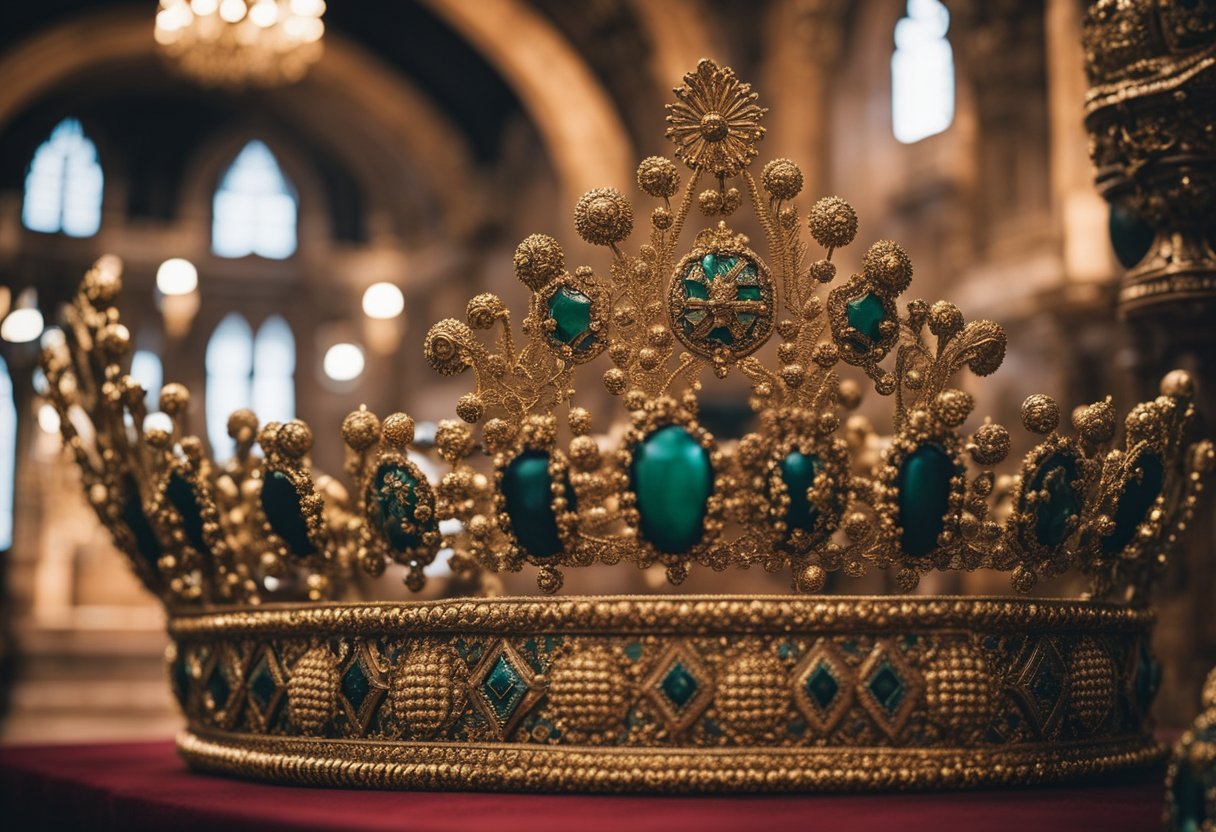
In the illustrious history of African royalty, regalia and symbols hold significant power and communicate leaders’ majesty, rank, and status. These items’ intricate designs and materials are not merely decorative but also imbued with cultural meaning and reverence.
Crowns, Staves, and Other Regalia
Crowns serve as the centrepiece of regalia, with their designs reflecting a monarch’s sovereignty and distinguished nature. For instance, crowns may be adorned with rare jewels and precious materials, signifying wealth and influence. The Nigerian king’s green beaded hat, for example, is not only a symbol of his rulership but also connects him to a lineage of past rulers and their enduring legacy.
Staves, often intricately carved and decorated, denote authority and are carried by royalty during ceremonial events to signify their right to rule. Other regalia, such as ornate robes and accessories, further distinguish the royal bearer from the populace, each aspect of their adornment exemplifying their elevated status and sacred duties.
Flags and National Symbols
Flags represent the identity of a nation and its people, often incorporating symbols with deep historical significance. For example, a national flag may feature icons representing the country and its monarchy for centuries.
National symbols, such as the Golden Stool of the Ashanti Empire, embody the nation’s very soul. This emblem of unity has remained a potent symbol of Ashanti authority and heritage, showcasing the deep connection between the cultural artefacts and the governance of the lands.
Our understanding of these elements highlights the reverence and respect afforded to African royalty and the enduring importance of cultural traditions.
Contemporary Royal Presence in the UK
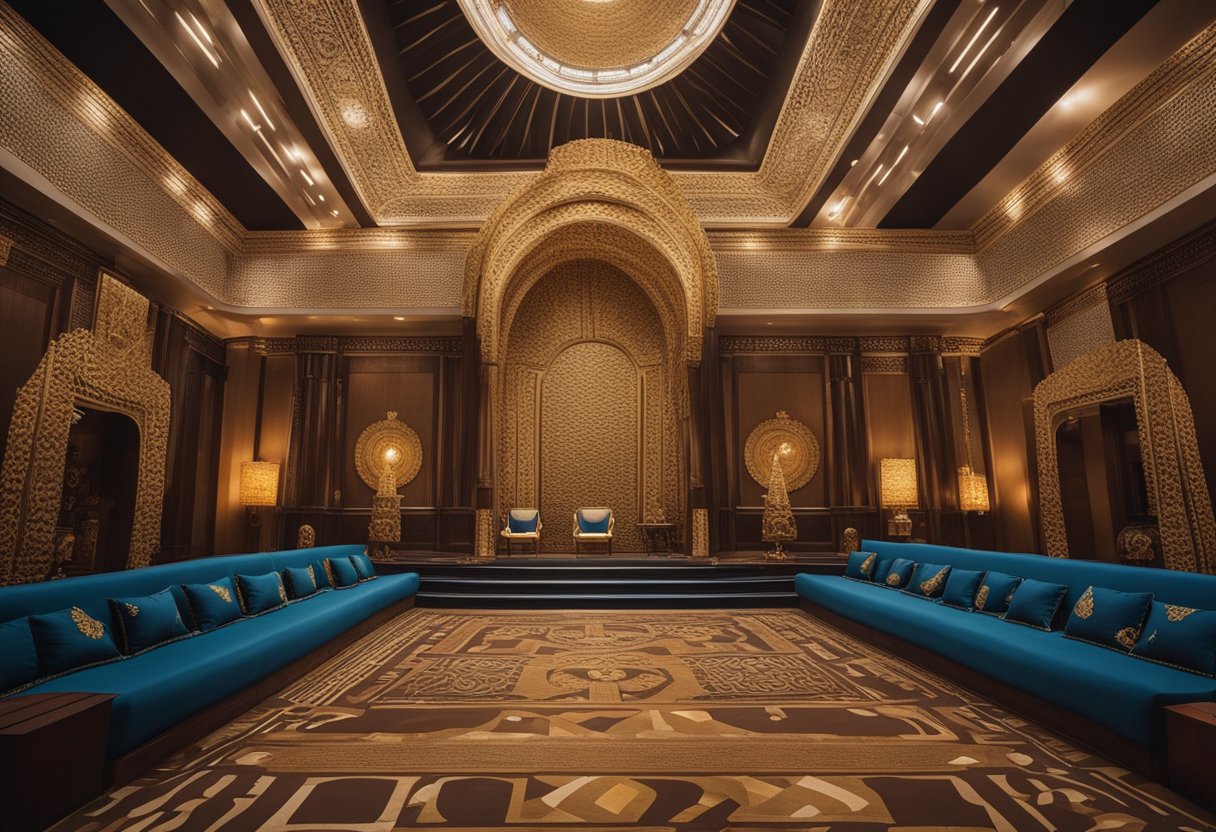
In the bustling metropolis of London, the influence and presence of contemporary African royalty and culture are vibrantly showcased, reflecting the enduring connections between the UK and Africa.
The Africa Centre in London
The Africa Centre, once situated on King Street in Covent Garden, has found a new home in Southwark. This former 1960s office block has been transformed into a cultural hub dedicated to contemporary African culture and heritage. Since its opening in June 2022, it is a testament to the historic links between the British Empire and Africa and a manifestation of the UK-based charity’s commitment to celebrating Africa and its diaspora. The venue features a pan-African restaurant, art gallery, and event spaces, becoming a cornerstone for African heritage in the heart of London. Visit The Africa Centre for more insights.
African Royalty in British Society
African royalty continues to influence the cultural landscape of the UK, as seen through various art exhibitions and societal engagements. One such instance is a photo displayed at London’s Tate Modern, capturing a Nigerian king in full regalia. This imagery underscores the complexity and richness of contemporary African monarchs’ roles. The symbolic representation of African royals in the UK, such as this one, speaks to a shared history and a continuing dialogue between the continents. Learn more about the representation of Contemporary African Royals within British society.
Influence on the African Diaspora
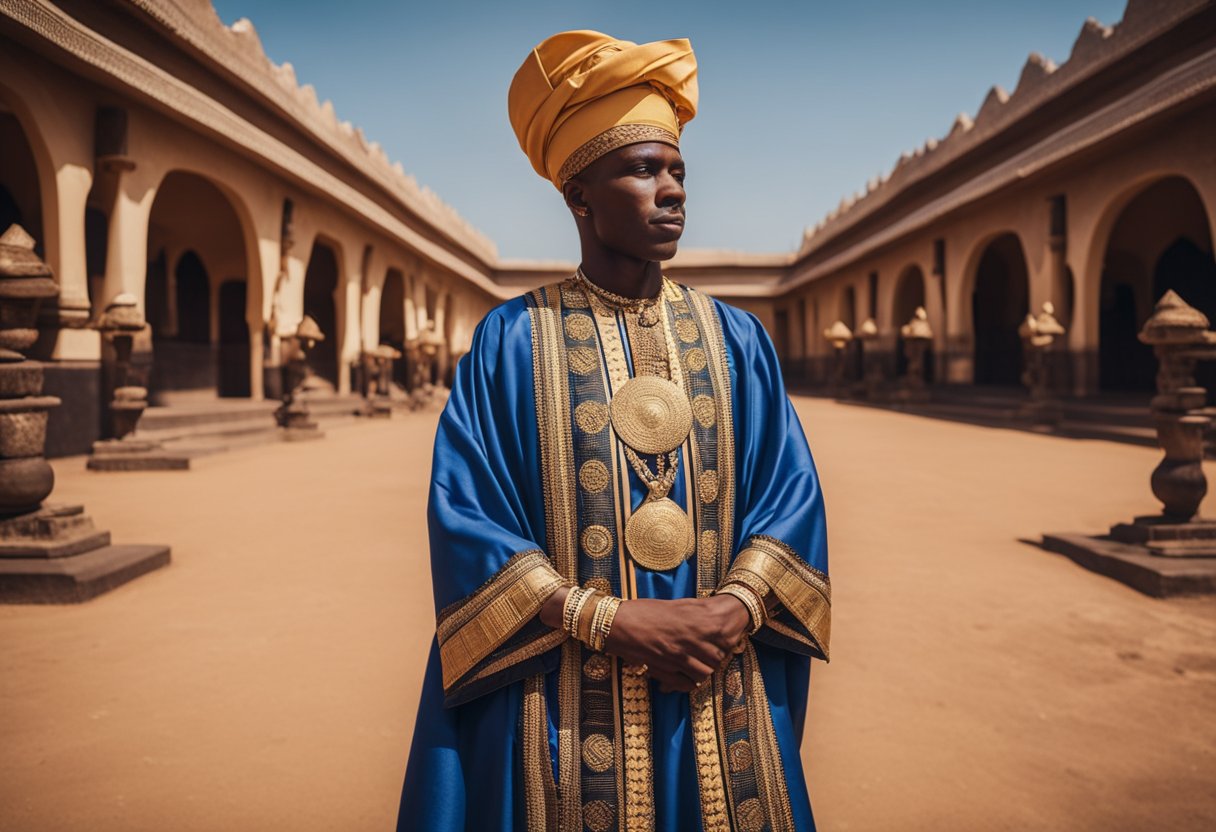
The Royal Courts of Africa have left a profound legacy that continues to shape the cultural identities and expressions of the African diaspora around the world.
Cultural Experiences Abroad
The diaspora carries rich cultural experiences from the African continent, which manifest through various artistic forms. For instance, African artists have found platforms globally, translating their heritage into music, fashion, and visual arts that resonate with broad audiences. From the intricate rhythms that influence contemporary music genres to the bold designs that grace international fashion weeks, the legacy of African majesty is unmistakable in diasporic cultural expressions.
Integration and Representation
Within the global diaspora, there’s an emphatic pursuit of integration and representation within the societies where individuals of African descent have settled. Civic engagement and cultural advocacy have led to increased visibility for African traditions and a greater respect for the heritage these communities bring. Whether by holding public office, creating community organisations or featuring in mainstream media, members of the African diaspora are amplifying their voice and thus, reaffirming the significance of their ancestral courts’ influence on their current status in society.
African Royal Advocacy and Charity Work
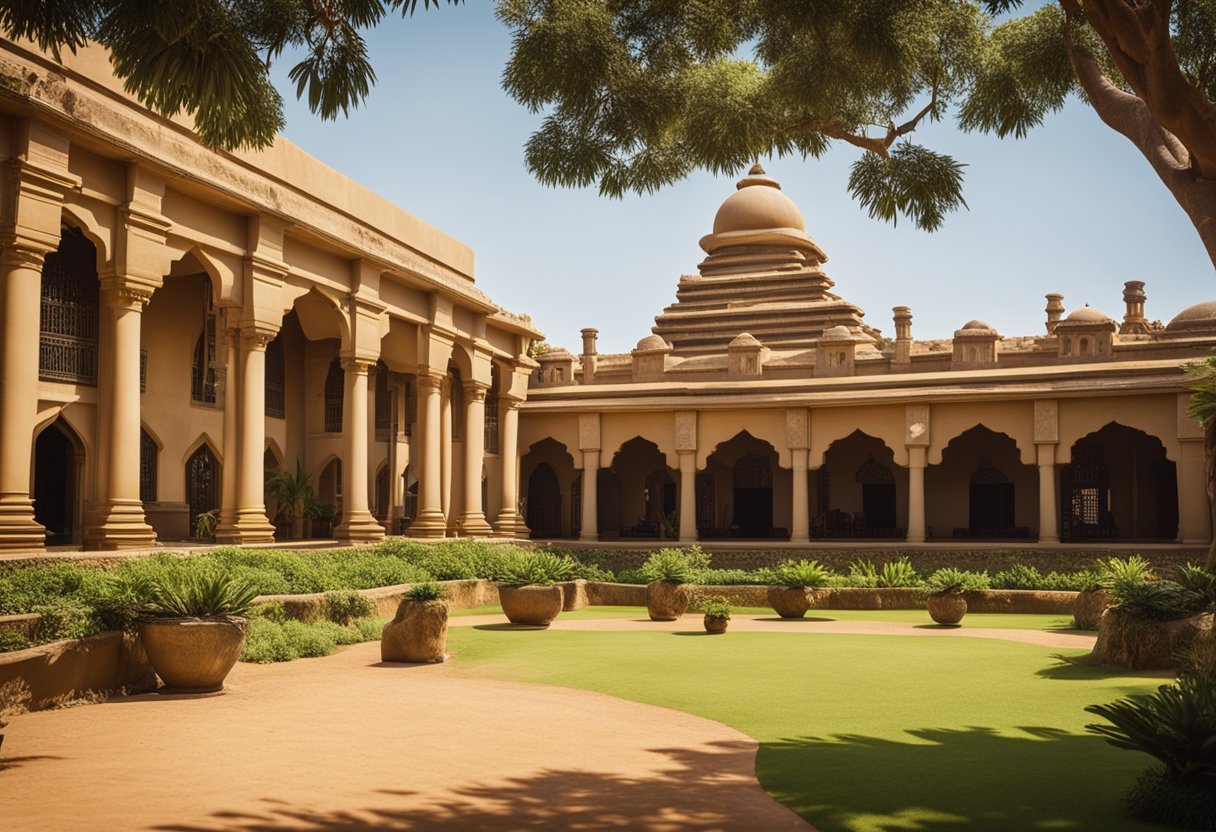
Royal African figures have long been at the forefront of various advocacy and charity initiatives. They leverage their influence and resources to address critical issues ranging from health crises to environmental challenges, actively engaging in social campaigns and economic equality efforts.
Social and Health Campaigns
African royalty have become pivotal supporters in the fight against health crises such as HIV, often acting as patrons to organisations dedicated to education, prevention, and treatment. For example, the work in Tanzania involving health advocacy showcases the commitment to tackling such issues head-on. These campaigns provide vital support networks and increase awareness, which is instrumental in reducing the spread of diseases.
- Health Advocacy:
- Patronage of health campaigns
- Education and prevention programs
- HIV:
- Support for HIV treatment and prevention charities
- Raising awareness to combat stigma
Environment and Economic Inequality Initiatives
The climate emergency and environmental and economic inequality are also areas to which African royals have dedicated their patronage. They are often associated with charities focused on conservation and sustainable development. With royal support, Tusk Trust illustrates the profound impact royals can have in championing conservation efforts and fighting environmental challenges.
- Environmental Advocacy:
- Support for wildlife conservation (e.g., Tusk)
- Climate change initiatives
- Economic Inequality:
- Economic development projects
- Advocacy for fair trade and equal opportunity
Cross-Cultural Dynamics
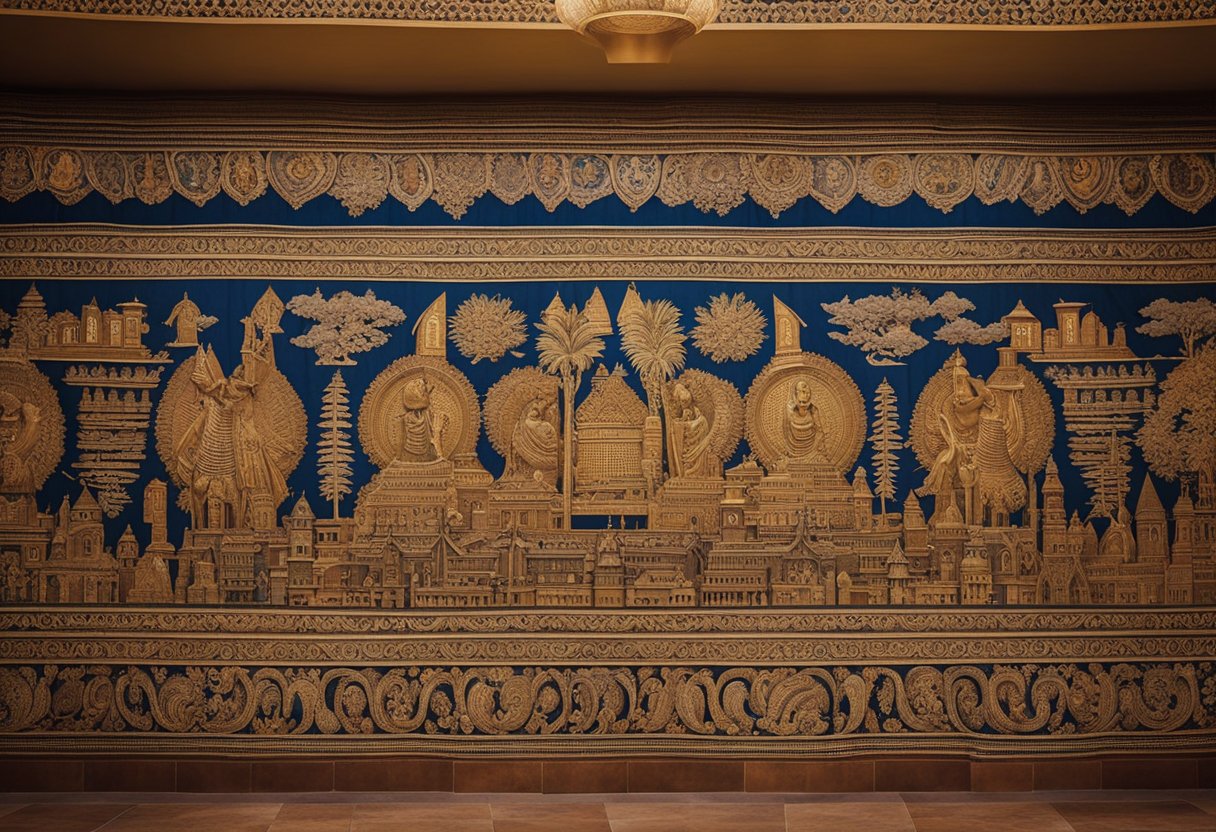
In this section, we will explore the intricate relationships between African and European royal families and the significant role African monarchs have played on the global stage.
African and European Royalty Relations
African and European royalty have a long, complex history punctuated by cooperation and conflict. Royal encounters were often laden with elaborate ceremonial receptions, displaying sovereignty and mutual respect. For example, during state visits to European nations, African rulers have been hosted in venues such as Buckingham Palace, symbolising unity and the gravity of diplomatic relations.
The Role of African Monarchs Globally
African monarchs, acting as representatives of their nations, hold a unique position in the global arena. Their role is not limited to governmental duties but extends to fostering non-governmental relations through cultural diplomacy and philanthropy. Their participation in international events, including those held in prominent locations like Covent Garden, extends their influence and promotes African heritage worldwide.
Looking Towards the Future

As we contemplate the royal courts of Africa, it is evident that a delicate balance between the allure of tradition and the pulse of modernisation will shape their trajectory. The pressing question is not if but how these institutions will adapt to the changing social landscape and expectations of younger generations.
Young Monarchs and Societal Change
Monarchies in Africa are increasingly seeing young successors who are well-educated and attuned to the challenges and opportunities of the 21st century. These youthful leaders are positioned to drive significant societal change. In countries like Eswatini, we observe young royals taking on leadership roles, incorporating innovative approaches to governance and public welfare while resonating with the cultural heritage substantiating their rule.
Adapting Traditions in the Modern World
The modern world is not a static theatre; it is a dynamic arena where traditions are not abandoned but rather adapted. With their long-standing heritage, African monarchies are crafting their futures by blending respect for customs with a proactive stance on modernisation. For instance, in the Zulu royal court, efforts towards gender equality and involvement in political discourse are ongoing, marking a progression that respects legacy while focusing on current societal shifts.
Frequently Asked Questions
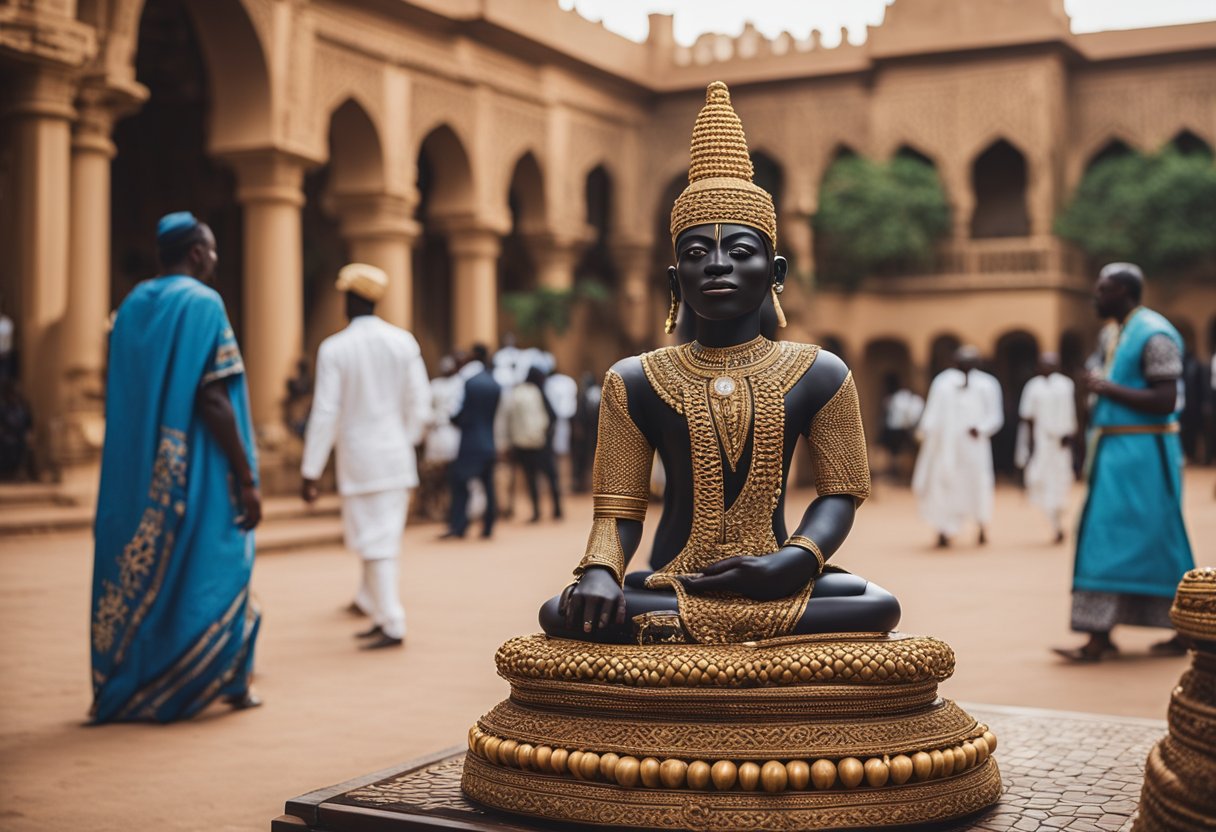
In this section, we explore some of the most common inquiries about the grandeur and heritage of African royal courts. These questions shed light on the intricacies of titles, heritage, cultural legacies, customs, and the impact of history on contemporary African royalty.
What titles are traditionally used to address members of African royalty?
In various African societies, members of royalty are often addressed by titles that signify their status and role. Examples include “King” or “Chief” in English translations. At the same time, local titles such as “Oba” in Yoruba land, “Asantehene” for the Asante people, and “Pharaoh” in ancient Egypt are deeply rooted in their respective cultures.
How does heritage influence the power structures of African royal courts?
Heritage plays a pivotal role in shaping the power structures of African royal courts. It defines succession lines, legitimises authority, and influences the governance systems within these monarchies. Each kingdom’s customs and traditional beliefs are integral to maintaining and reinforcing the power and influence of their courts.
Which African societies are known for their historical monarchies and regal traditions?
Historical monarchies and regal traditions are prominent in several African societies. The regal traditions of ancient Egypt are renowned globally, while West Africa boasts powerful empires such as Mali, Ghana, and Songhai. The Zulu kingdom in Southern Africa is also known for its royal lineages and traditions.
In what ways are the cultural legacies of African royal courts preserved and celebrated today?
Today, the cultural legacies of African royal courts are preserved through various forms of expression, from oral history and traditional ceremonies to modern-day cultural festivals and museums. These practices ensure the transmission of royal heritage and history from generation to generation, often attracting global interest.
What are some notable customs and ceremonies unique to royal courts in Africa?
African royal courts have unique customs and ceremonies, including elaborate coronations, traditional regalia, and ritual performances that convey royal authority. Regular events such as the Durbar festival in Nigeria showcase equestrian skills and serve as a platform for royal courts to interact with the public.
How do historical African royal courts compare to their contemporary counterparts?
Historical African royal courts were often centralised and held absolute power, serving as the primary governance and social order structure. Contemporary counterparts may have symbolic or constitutional roles, and although they retain cultural significance, their direct political influence is generally reduced.






